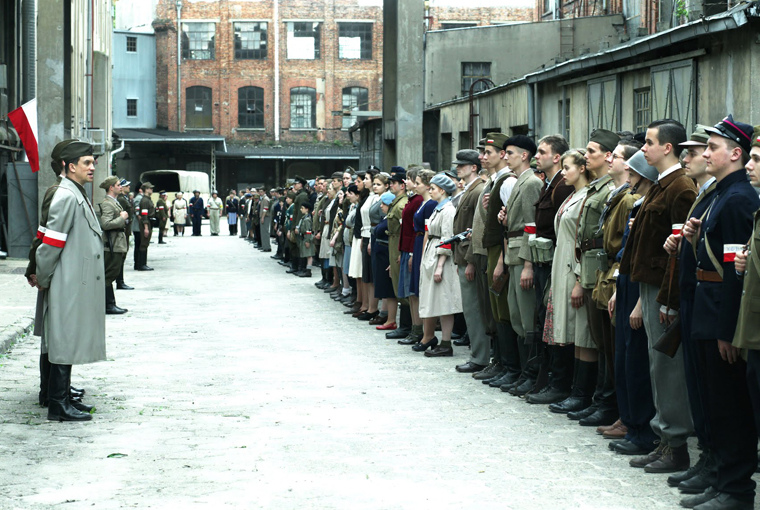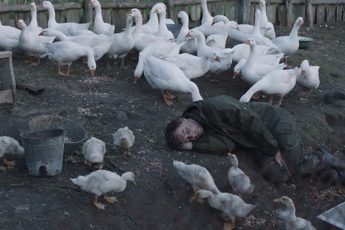The Real Hunger Games
Jan Komasa’s Warsaw ’44 (Miasto ’44, 2014) and Warsaw Uprising (Powstanie Warszawskie, 2014)
Vol. 50 (February 2015) by Colette de Castro
Jan Komasa’s debut feature Suicide Room introduced this ambitious young director to the international scene in 2011. Praised by both Polanski and Wajda, the film portrayed the internet generation in an insightful and dramatic way. Komasa managed to produce a film which is at once sensitive and startling, focusing on the troubles and eventual suicide of an unhappy teenage boy whose self-slaughter was precipitated by his participation in an online chat room, where his interactions with other members reinforced his isolation and fueled his hatred of the outside world.
The film was a success within its genre. Our own review of the film received the largest number of comments this website has ever received. Most of them came from teenagers who said they could relate to the film’s protagonist. Rose D. said, “I litraly (sic) just watched the movie and it was breathtaking. To be honest I never really understood what suicide was and why until this movie.” That they should actively comment on a review of a Eastern European film reveals its reach and broad appeal.
The energy and inspirational force of Suicide Room surely explain why Komasa was supported by the Polish Film Institute in the production of his second feature, Warsaw 44. Komasa was given the monumental task of restaging the tragic events of the Warsaw Uprising 1944. While the Soviet Army was approaching from the East towards the end of WWII, the Home Army rose up against the Nazis in Warsaw. Unfortunately, his historical fiction feature lacks the authenticity of the internet-age teenager’s dark portrait. It tries, in vain, to copy Hollywood. Rather than focusing on the actual events, the film focuses on a group of young, photogenic teenagers, who fall in love and gallivant around Warsaw, doing their best to survive and literally dodging bullets. Only when they stop to catch their breath do they remember to call by and free the remaining Jewish prisoners. There is at least one slow-motion scene where our hero Stefan (Józef Pawłowski) runs through a graveyard lithely avoiding German gunfire…
So while it doesn’t teach us much about history, the film does highlight a trend about how the Second World War is dealt with in Polish film today. The feeling one gets from the film, which resonates with what was said in the editorial summary of our Poland focus 2014, is that it’s an attempt to make Polish heroism attractive, youthful and rather naive. This attempt to paint a Manichean picture – good versus evil – is rather simplistic, even for Hollywood. The film characterizes a young and sexy Polish youth who are quite simply unaware of the political dangers and the many complications of being on the ‘wrong’ side.
In considering Warsaw 44, it’s useful to watch another of Komasa’s productions, The Warsaw Uprising (hereafter referred to as ‘the documentary’), that was created for the Warsaw Memorial Museum. A recreation of original footage from newsreels made in August 1944, Komasa made it a few months before his fiction film. These newsreels were filmed during the uprising and shown in the evenings at the Warsaw Palladium to encourage the Home Army after (and before) combats – a sort of internal propaganda for a tragic cause. Komasa actually makes a clever reference to the footage in his fiction film, when he portrays the interior of the Palladium and a crowd of viewers watching rushes from something called “Warsaw is Fighting”.
Of course, the documentary footage that survives from a revolution is always fragmentary and unreliable, and here we only see the events in the city center. Many images are remarkable: groups of policemen unearthing a corpse from a pile of rubble, a smiling woman in a military suit with blood running down her face… But on the whole the documentary records mostly mundane scenes, showing the messiness of war, the hanging-around, the flirting, the boredom, the everyday.
Although an annoying voice-over has been added to the documentary, the value of this film as a historical record outweighs any editorial meddling. The film was commissioned for an exhibition at the Warsaw Memorial Museum, which perhaps explains the incongruous American voice-over.
It’s interesting to consider whether the director has taken any of the ideas from the documentary over to the fiction film, but this is rarely the case. In the original footage there is a kind of communitarian ideology which shines through those historical images. Groups of young people sit around and chat while preparing bombs, casually helping each other out. The cliché that truth is stranger than fiction is appropriate here and it seems that there is an unnecessary desire to over-dramatize this kind of interesting situation in the fiction film.
Both the documentary and the fiction film begin with title cards explaining the historical context. One of them is particularly blunt, stating: “The battle for the capital will decide the future of the nation.” Although such a dramatic sentence can help bring the documentary to life, in the fiction film it is reminiscent of the current craze for dystopian films. Successful blockbusters like The Hunger Games and Divergent both deal with groups of teenagers who fight against enemy forces, among whom true love and disgust for totalitarianism brings them together in their heroic battle. Watching a group of young, idealistic teenagers in Warsaw 44, one can’t help but associate it with this tried and tested recipe for commercial success. Such similarities call into question whether a film which brags about being ‘based on real events’ such as Warsaw 44, should really be given the same freedom as those which are adapted from best-selling fiction.
Maybe part of the reason directors tend to over-dramatize historical fiction today is a misplaced idea that their history is not interesting enough to young Europeans and that in order to succeed commercially, these films have to be presented like blockbusters.
If Komasa wanted to make big budget action drama movies he should have done it properly. Unfortunately, the feeling comes across that he has used his privileged position as a renowned filmmaker, and his close-up experience with the sensitive footage which makes up The Warsaw Uprising, to turn a profit with Warsaw 44. While everyone is a hero in the documentary, Komasa gave us a revised view of history and reason to believe there are better-looking heroes in the fiction film.




Sorry but there was no “wrong side”